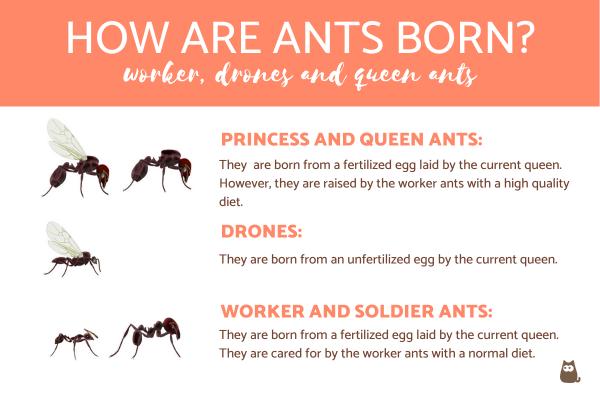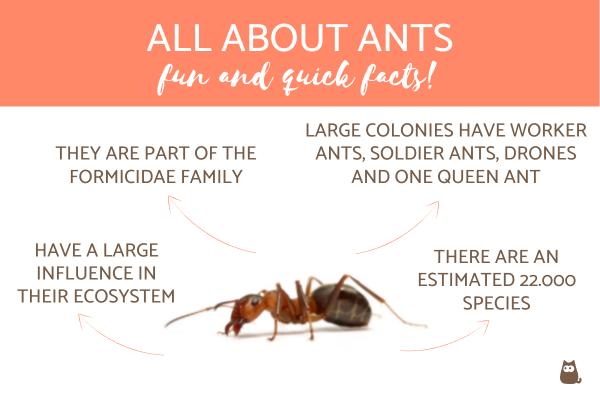
In this AnimalWised article we're going to talk about how ants are born, their reproduction system, the organization of their ant colony and more! Keep reading to learn more!
About ants
Ants (Formicidae) are one of the most interesting and important soil insects as they probably have the most influence on our soil structure than any other insect. We often see them standing in long lines as they carry their food to the anthill.
Their social organization, their cooperation and their motivation to work is something that attracts everyone's attention. However, many people do not know what happens inside the anthill, how ants are born or even what queen ants are.
Let's first look into the organization of an ant colony. Then we can take a look at how worker ants are born, and how queen ants are born. Below, we leave you some fun and quick facts about ants!
You may also be interested in our article about why ants carry dead insects.

The ant colony and its organization
In order to understand how ants are born, it is very important to know their organization. There are an estimated 22.000 species of ants in the world that differ in certain aspects, however, they all have a very similar social organization. This social structure is what makes ants so successful in surviving and thriving in their ant colonies.
Where do ants live?
Ants live in an anthill. They build tunnels and chambers under the ground, in wood or even in living plants, giving rise to large “cities” where thousands of ants live. In this way, they form quite complex societies.
This complex social structure they have developed is called an ant colony. These colonies are described as superoraganisms as the ants appear to operate as a complete entity, working together to support their colony.
How does a colony work?
Colonies work when each ant is doing their duty. In these colonies we often find different types of ants carrying out one task for the function of their colony. They are as follows:
- Worker ants: these are present in large colonies, they are large wingless females. Also known as ergates. These types of ants do various tasks to make sure the colony is thriving. Some of those tasks involves tending to the eggs, such as cleaning and feeding them. They also take out the trash from the anthill and search for food and supplies.
- Soldier ants: large wingless females can also be soldiers. Also known as dinergates. Their goal is to defend and protect the queen, their colony, gather or kill food and attack enemy colonies that are in competition for food or a nesting place.
- Drones: all ant colonies have some fertile males called drones, also known as aner. Their only function is to mate with the queen so they can reproduce and maintain a functioning colony. Drones die as soon as they've fulfilled this function and are rarely found outside of the colony.
- Queen ant: lastly, we have one (or in some colonies more) queen ant, also known as gynes. Their only function is to lay eggs to keep growing the colony.
You may also be interested in our article about the different types of ants around the world.
How male and female ants are born
Ant colonies are eusocial, which means that they have a complex social system that revolves around one female in charge of the reproduction of their colony. With that being said, let's take a look at how male and female ants are born:
Birth of female ants
The queen copulates with the drones, the male ants. After this encounter, the queen lays the eggs in strategic places in the anthill, but does not carry out any kind of parental care. It is the worker ants who are in charge of protecting and cleaning the eggs, awaiting the birth of the new ants.
When the eggs hatch, the newborn ant is still a worm-shaped larvae. They are born headless, unable to see, walk, or feed themselves. For this reason, the workers take care of them and feed them until they become adults.
When ready to become an adult, each larva is covered in a hard substance, entering a phase known as the “pupa”. This is similar to the cocoon of a butterfly. This is when the legs, antenna, jaws, etc of the ant is formed, giving them the body of an adult ant.
This is how female eggs are born. So, let's take a look at how male ants are born...
Birth of male ants
Male ants or drones are winged ants that hatch from unfertilized eggs. Therefore, in order for drones to be born, the queen ant lays them without having copulated with a male.
It should be noted that on very special occasions, certain workers can lay male eggs. Worker ants have the ability to lay eggs, but they don't because the queen inhibits their ovaries with pheromones. However, when the colony grows too large, the pheromones do not circulate throughout the nest. Therefore, at some distance from the queen, some workers can lay unfertilized eggs, which will give rise to males.
If you want to see how an ant is born, don't miss the video below!

How a queen ant is born
Now that we've seen how male and female ants are born, let's take a look at how queen ants are born as it's a very unique and interesting event in the reproduction of ants.
The birth of queen ants doesn't differ in genetics but in their upbringing. Queen ants are made, like any other female ant, but are fed differently. When a worker ant is raising a queen ant, they give the larvae a high quality diet so they can develop into a queen ant.
It is not the worker ants choice whether to raise another queen ant, it's the current queen ant that decides whether the colony needs another queen ant. They do this by leaving specific signs where they lay the egg to indicate that this egg must be raised as a queen ant. The workers recognize the signs and obey.
As a result, the chosen larvae grow larger and develop a different shape during their metamorphosis. They are winged ants that leave the colony when the most favorable environmental conditions arrive. Outside, they mate with drones, also winged, and perform a nuptial flight in which copulation takes place.
Finally, each of the new winged queens looks for a place to build their own anthill where their own ant colony will live. Once there, they lose their wings and lay the eggs that will give rise to their first larvae. She feeds them by regurgitation (bringing swallowed food up again to the mouth). These ants all become workers. The queen ant will only order a new queen ant when their colony is at a sufficient size to bring up a new queen, starting a new cycle.
If you want to read similar articles to How Are Ants Born?, we recommend you visit our Facts about the animal kingdom category.
Gullan, PJ, & Cranston, PS (2014). The insects: an outline of entomology . John Wiley & Sons.